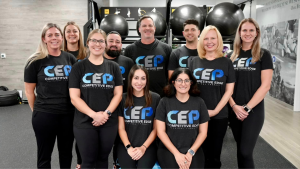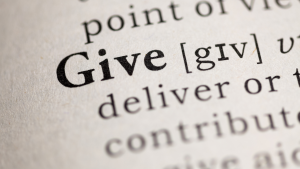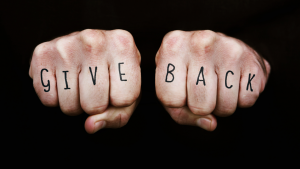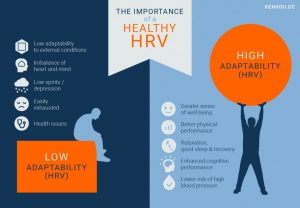
Home Exercises to Beat Neck Pain
Do you struggle with neck pain? If yes, then you’re in the majority. A recent Neck Pain and Lower Back Pain study completed in March of 2020 indicates that neck pain is the fourth leading cause of disability.
Luckily, the study goes on to suggest that acute neck pain typically resolves in two months and, with the right treatment, can resolve even faster. Neck pain is a self-limiting diagnosis that can lead to radicular symptoms to the Upper extremities or headaches.
Neck pain, or cervicalgia, is multifactorial and can appear for a wide variety of reasons, including:
- Cervical disc herniation
- Muscle imbalance
- Postural abnormalities (upper crossed syndrome)
- Poor exercise form
- Extensive work related postural positioning (computer work)
- Stress-induced
Neck Pain: A Self-Limiting Diagnosis
The most common imbalance leading to general neck pain is called Upper Crossed Syndrome, a diagnosis named by Vladimir Janda, MD.
Upper crossed syndrome is an imbalance in upper quarter musculature that leads to postural abnormalities ultimately causing cervical pain and dysfunction.
These postural abnormalities include a forward translation of the head and shoulders as well as a rounded back. If left uncorrected, this can contribute to the development of chronic issues in the cervical spine.
Tight muscles include:
- Upper trap
- Levator scapula
- Pectoralis muscle group
Weak muscles include:
- Deep neck flexors
- Lower trap
- Serratus anterior
These muscle imbalances cause the shoulders to round through elevation and anterior translation of the scapula (scapular winging) and the head to develop a forward tilt.This anatomical misalignment leads to increased pressure on the cervical vertebra, vertebral discs and associated structures.
Essentially, while looking from a side view, you should be able to draw a straight line from a person’s anterior shoulder to their ear. With upper crossed syndrome, the head would fall in front of that imaginary line.
Relieving Neck Pain with Custom Therapy Programs
Although intimidating, a comprehensive and individualized program can help to correct these postural abnormalities and reduce pain.
In a 2020 Randomized control trial, it was determined that a lower trap strengthening exercise program is an effective method with clinical significance for reducing the level of neck dysfunction and improving the postural alignment, muscle thickness and contraction rate of the lower trap muscle.
At Competitive Edge Performance, we utilize a specialized form of electrical stimulation called the NEUBIE machine. In contrast to the traditional TENS e-stim unit, the NEUBIE uses a direct current stimulation to send signals precisely to where you’re experiencing pain or muscle movement limitations, ultimately re-educating your muscles by tapping into the nervous system.
Initiation of the NEUBIE begins with the mapping process. This process allows the therapist you work with to determine the source of pain or dysfunction with 100% accuracy every visit, leading to improved accuracy of treatment and accelerated treatment times.
The NEUBIE is FDA approved for the following uses:
- Maintaining or increasing range of motion
- Increasing local blood circulation
- Neuromuscular re-education
- Preventing muscle atrophy
- Reducing muscle spasms
- Preventing venous thrombosis after surgery
- Management or relief of chronic pain
- Management of post-surgical and post-traumatic acute pain
For more information, please visit NeuPTtech for more information on how this breakthrough technology is changing the way physical therapy is practiced.
DIY Exercises for Muscle Imbalance with Upper Crossed Syndrome
The following exercises address the muscle imbalances that are associated with upper crossed syndrome. They can be performed at home with minimal equipment, and should be done so 4-5 times per week.
Please understand these exercises are safe and effective for anyone to perform, but a full evaluation should be performed by a medical professional if you are worried about initiating a home exercise program.
This content is not a substitute for professional medical advice, diagnosis or treatment and if pain is present with these movements, seek an evaluation with a physical therapist or orthopedic specialist.
Upper Trap Stretch
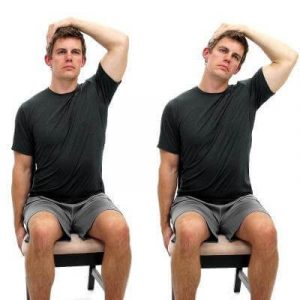
- Please perform stretches sitting in chair with back support
- Anchor your hand to the bottom of the chair to maintain appropriate scapular positioning
- Place opposite hand on your head to assist in stretching movement and to provide slight overpressure
- Hold 30 seconds to 1 minute
Levator Scapulae Stretch
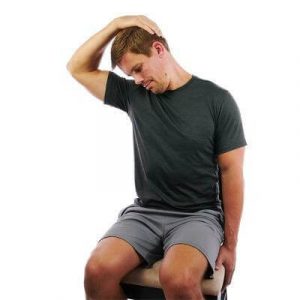
- Please perform stretches sitting in chair with back support
- Anchor your hand to the bottom of the chair to maintain appropriate scapular positioning
- Place opposite hand on your head to assist in stretching movement and to provide slight overpressure
- Hold 30 seconds to 1 minute
Chest (Pec) Stretch
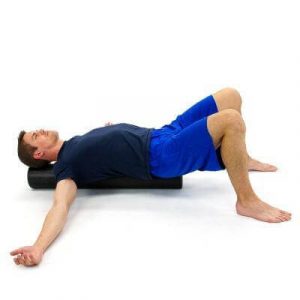
- Place foam roller or rolled towel vertically along spine
- Allow your arms to drop towards the floor with straight elbows
- Hold 30 seconds to 1 minute
Scapular Retractions
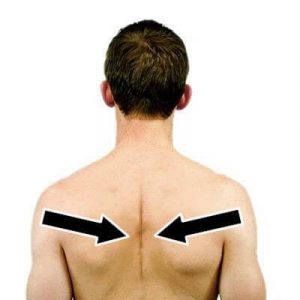
- Squeeze shoulder blades together and down
- Be careful to avoid upper trap activation – shoulders should not elevate
- Perform 3 sets of 10 repetitions, maintain 2-3 second isometric hold with each repetition
Chin Tucks
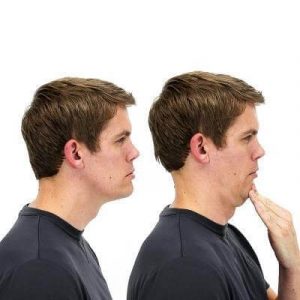
- Pull chin inward as if you were making a double chin
- Avoid excessive shoulder/chest movement during exercise
- Perform 3 sets of 10 repetitions, maintain 2-3 second isometric hold with each repetition
Rows
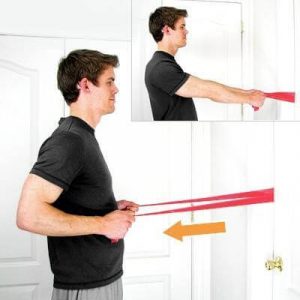
- Use an elastic band
- Start with arms straight, ensure appropriate scapular retraction, draw back band as you bend your elbows
- Be sure to keep elbows close to body
- Perform 3 sets of 10 repetitions, maintain 2-3 second isometric hold with each repetition
Horizontal Abduction

- Start with band or tubing with arm stretched across your body
- While maintaining straight arm, pull elastic band horizontally across your body as shown
- Perform 3 sets of 10 repetitions, maintain 2-3 second isometric hold with each repetition
- This can be performed with or without resistance band
Y’s

PLEASE NOTE: All stretching and exercise images were sourced from hep2go.com.
Schedule Physical Therapy with CEP
Schedule your next-generation PT with the physical therapists at CEP today. We are passionate about helping people live active lives at their optimal health status and we believe our physical therapy technologies and methods will help you too.


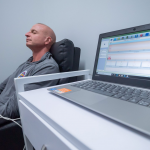 Previous Post
Previous Post Next Post
Next Post